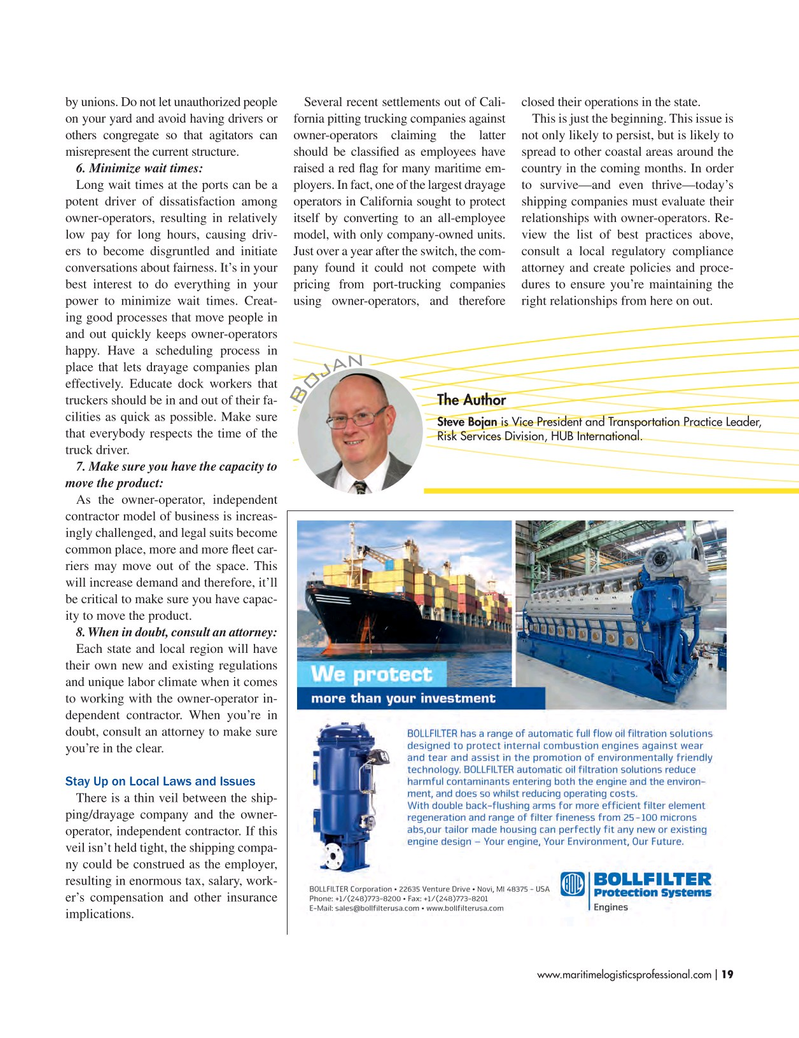
Page 19: of Maritime Logistics Professional Magazine (May/Jun 2017)
BUNKER OPERATIONS & PORTS
Read this page in Pdf, Flash or Html5 edition of May/Jun 2017 Maritime Logistics Professional Magazine
by unions. Do not let unauthorized people Several recent settlements out of Cali- closed their operations in the state. on your yard and avoid having drivers or fornia pitting trucking companies against This is just the beginning. This issue is others congregate so that agitators can owner-operators claiming the latter not only likely to persist, but is likely to misrepresent the current structure. should be classifed as employees have spread to other coastal areas around the 6. Minimize wait times: raised a red fag for many maritime em- country in the coming months. In order
Long wait times at the ports can be a ployers. In fact, one of the largest drayage to survive—and even thrive—today’s potent driver of dissatisfaction among operators in California sought to protect shipping companies must evaluate their owner-operators, resulting in relatively itself by converting to an all-employee relationships with owner-operators. Re- low pay for long hours, causing driv- model, with only company-owned units. view the list of best practices above, ers to become disgruntled and initiate Just over a year after the switch, the com- consult a local regulatory compliance conversations about fairness. It’s in your pany found it could not compete with attorney and create policies and proce- best interest to do everything in your pricing from port-trucking companies dures to ensure you’re maintaining the power to minimize wait times. Creat- using owner-operators, and therefore right relationships from here on out. ing good processes that move people in and out quickly keeps owner-operators happy. Have a scheduling process in n place that lets drayage companies plan a j effectively. Educate dock workers that o truckers should be in and out of their fa-
The Author
B cilities as quick as possible. Make sure
Steve Bojan is Vice President and Transportation Practice Leader, that everybody respects the time of the
Risk Services Division, HUB International. truck driver.
7. Make sure you have the capacity to move the product:
As the owner-operator, independent contractor model of business is increas- ingly challenged, and legal suits become common place, more and more feet car- riers may move out of the space. This will increase demand and therefore, it’ll be critical to make sure you have capac- ity to move the product. 8. When in doubt, consult an attorney:
Each state and local region will have their own new and existing regulations and unique labor climate when it comes to working with the owner-operator in- dependent contractor. When you’re in doubt, consult an attorney to make sure you’re in the clear.
Stay Up on Local Laws and Issues
There is a thin veil between the ship- ping/drayage company and the owner- operator, independent contractor. If this veil isn’t held tight, the shipping compa- ny could be construed as the employer, resulting in enormous tax, salary, work- er’s compensation and other insurance implications. www.maritimelogisticsprofessional.com 19
I

 18
18

 20
20
